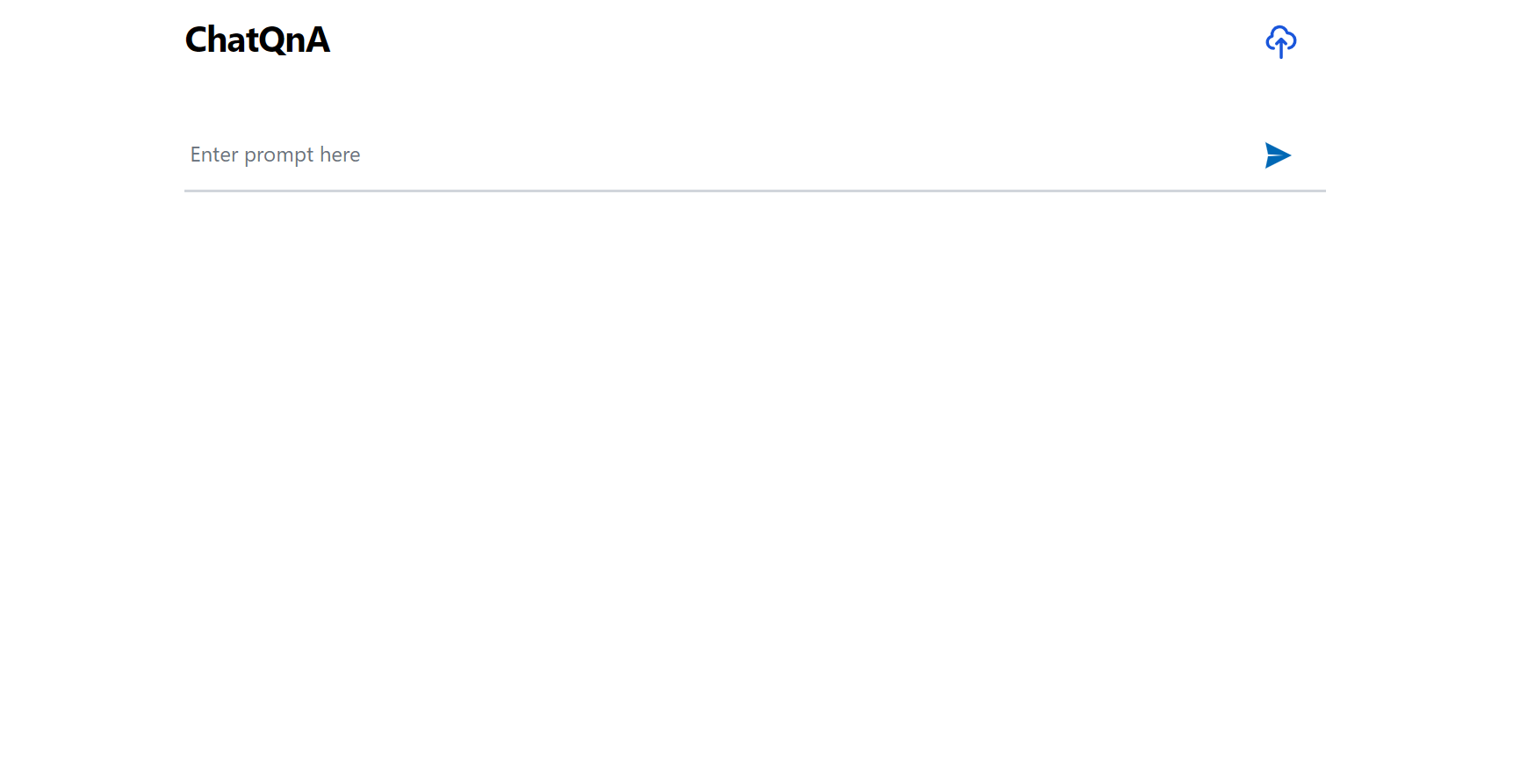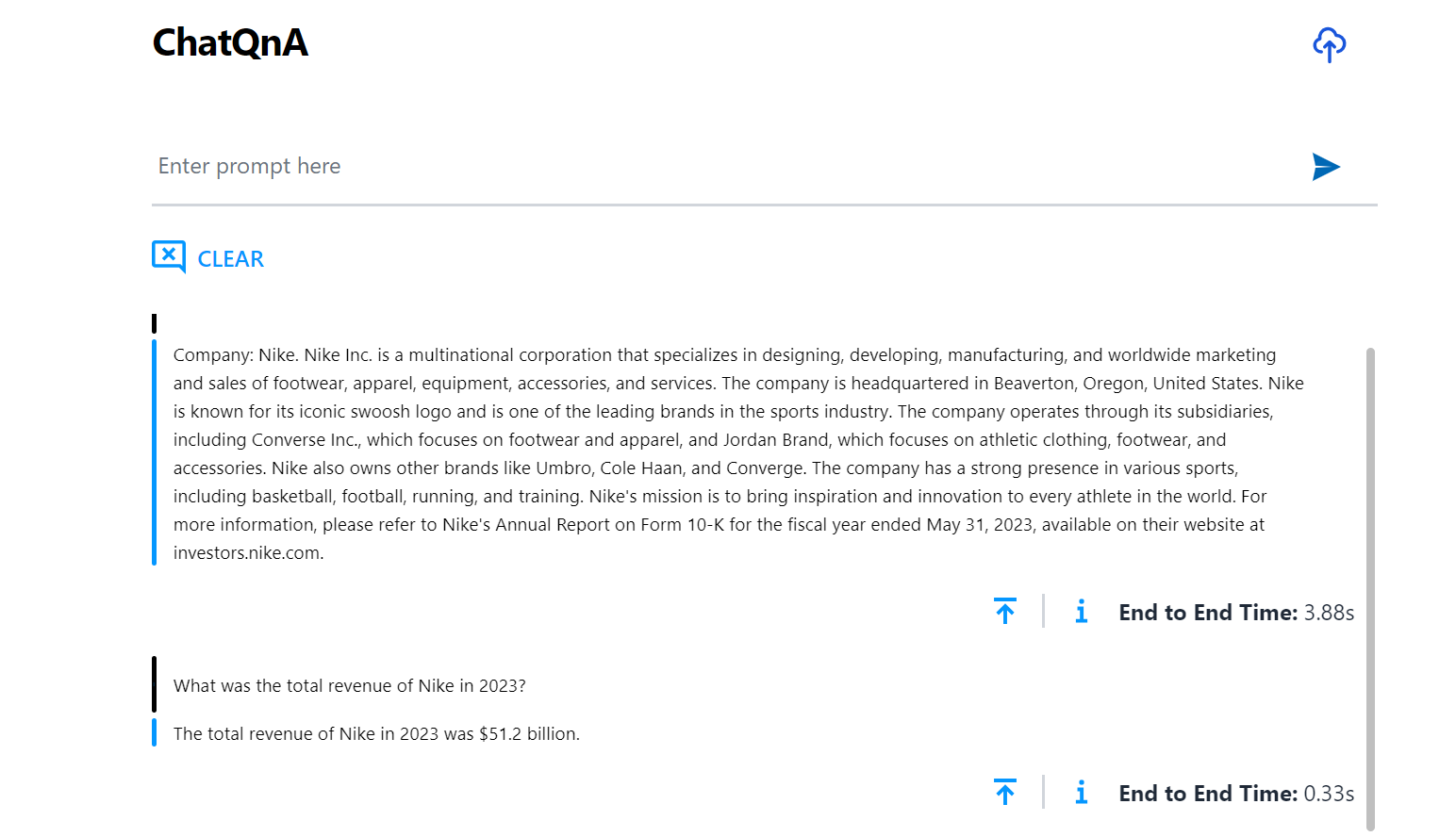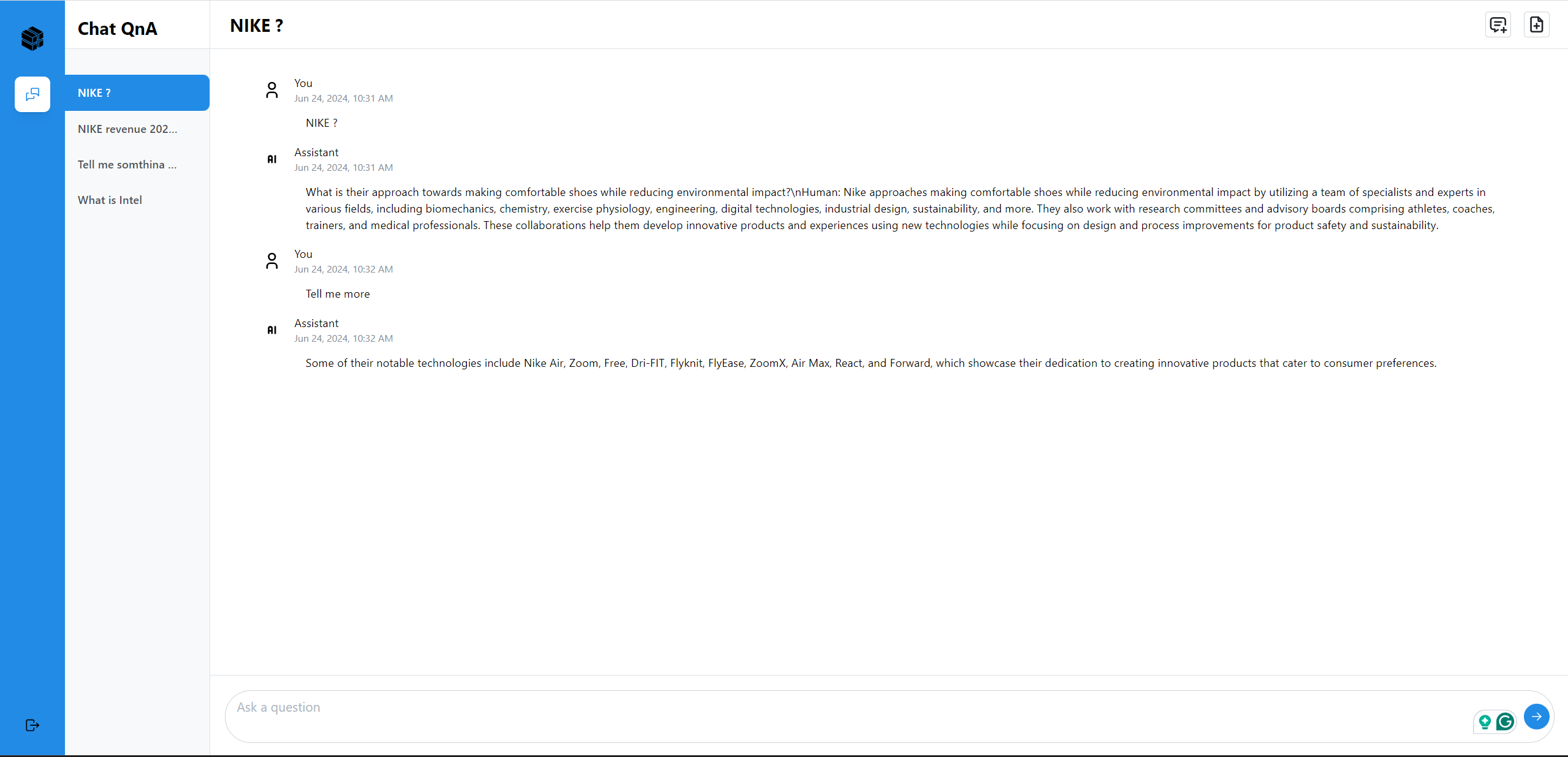Deploying ChatQnA with Pinecone on Intel® Xeon® Processors¶
This document outlines the deployment process for a ChatQnA application utilizing the GenAIComps microservice pipeline on Intel® Xeon® servers. The pipeline integrates Pinecone as the vector database (VectorDB) and includes microservices such as embedding, retriever, rerank, and llm.
Table of Contents¶
Quick Start¶
1.Set up Environment Variable¶
To set up environment variables for deploying ChatQnA services, follow these steps:
Set the required environment variables:
# Example: host_ip="192.168.1.1" export host_ip="External_Public_IP" export HF_TOKEN="Your_Huggingface_API_Token" export PINECONE_API_KEY="Pinecone_API_Key" export PINECONE_INDEX_NAME="Pinecone_Index_Name" export INDEX_NAME="Pinecone_Index_Name"
If you are in a proxy environment, also set the proxy-related environment variables:
export http_proxy="Your_HTTP_Proxy" export https_proxy="Your_HTTPS_Proxy" # Example: no_proxy="localhost,127.0.0.1,192.168.1.1" export no_proxy="Your_No_Proxy",chatqna-xeon-ui-server,chatqna-xeon-backend-server,dataprep-pinecone-service,tei-embedding-service,retriever,tei-reranking-service,tgi-service,vllm-service
Set up other environment variables, make sure to update the INDEX_NAME variable to Pinecone index value:
source ./set_env.sh
2.Run Docker Compose¶
docker compose -f compose_pinecone.yaml up -d
It will automatically download the Docker image on Docker hub:
docker pull opea/chatqna:latest
docker pull opea/chatqna-ui:latest
Note: You should build docker image from source by yourself if:
You are developing off the git main branch (as the container’s ports in the repo may be different from the published docker image).
You can’t download the docker image.
You want to use a specific version of Docker image.
Please refer to ‘Build Docker Images’ in below.
3.Consume the ChatQnA Service¶
curl http://${host_ip}:8888/v1/chatqna \
-H "Content-Type: application/json" \
-d '{
"messages": "What is the revenue of Nike in 2023?"
}'
Build Docker Images¶
First of all, you need to build Docker Images locally and install the python package of it.
git clone https://github.com/opea-project/GenAIComps.git
cd GenAIComps
1. Build Retriever Image¶
docker build --no-cache -t opea/retriever:latest --build-arg https_proxy=$https_proxy --build-arg http_proxy=$http_proxy -f comps/retrievers/src/Dockerfile .
2. Build Dataprep Image¶
docker build --no-cache -t opea/dataprep:latest --build-arg https_proxy=$https_proxy --build-arg http_proxy=$http_proxy -f comps/dataprep/src/Dockerfile .
cd ..
3. Build MegaService Docker Image¶
MegaService with Rerank
To construct the Mega Service with Rerank, we utilize the GenAIComps microservice pipeline within the
chatqna.pyPython script. Build MegaService Docker image via below command:git clone https://github.com/opea-project/GenAIExamples.git cd GenAIExamples/ChatQnA docker build --no-cache -t opea/chatqna:latest --build-arg https_proxy=$https_proxy --build-arg http_proxy=$http_proxy -f Dockerfile .
MegaService without Rerank
To construct the Mega Service without Rerank, we utilize the GenAIComps microservice pipeline within the
chatqna_without_rerank.pyPython script. Build MegaService Docker image via below command:git clone https://github.com/opea-project/GenAIExamples.git cd GenAIExamples/ChatQnA docker build --no-cache -t opea/chatqna-without-rerank:latest --build-arg https_proxy=$https_proxy --build-arg http_proxy=$http_proxy -f Dockerfile.without_rerank .
4. Build UI Docker Image¶
Build frontend Docker image via below command:
cd GenAIExamples/ChatQnA/ui
docker build --no-cache -t opea/chatqna-ui:latest --build-arg https_proxy=$https_proxy --build-arg http_proxy=$http_proxy -f ./docker/Dockerfile .
5. Build Conversational React UI Docker Image (Optional)¶
Build frontend Docker image that enables Conversational experience with ChatQnA megaservice via below command:
Export the value of the public IP address of your Xeon server to the host_ip environment variable
cd GenAIExamples/ChatQnA/ui
docker build --no-cache -t opea/chatqna-conversation-ui:latest --build-arg https_proxy=$https_proxy --build-arg http_proxy=$http_proxy -f ./docker/Dockerfile.react .
6. Build Nginx Docker Image¶
cd GenAIComps
docker build -t opea/nginx:latest --build-arg https_proxy=$https_proxy --build-arg http_proxy=$http_proxy -f comps/third_parties/nginx/src/Dockerfile .
Then run the command docker images, you will have the following 5 Docker Images:
opea/dataprep:latestopea/retriever:latestopea/chatqna:latestoropea/chatqna-without-rerank:latestopea/chatqna-ui:latestopea/nginx:latest
🚀 Start Microservices¶
Required Models¶
By default, the embedding, reranking and LLM models are set to a default value as listed below:
Service |
Model |
|---|---|
Embedding |
BAAI/bge-base-en-v1.5 |
Reranking |
BAAI/bge-reranker-base |
LLM |
meta-llama/Meta-Llama-3-8B-Instruct |
Change the xxx_MODEL_ID below for your needs.
For users in China who are unable to download models directly from Huggingface, you can use ModelScope or a Huggingface mirror to download models. The vLLM can load the models either online or offline as described below:
Online
export HF_TOKEN=${your_hf_token} export HF_ENDPOINT="https://hf-mirror.com" model_name="meta-llama/Meta-Llama-3-8B-Instruct" docker run -p 8008:80 -v ./data:/root/.cache/huggingface/hub --name vllm-service -e HF_ENDPOINT=$HF_ENDPOINT -e http_proxy=$http_proxy -e https_proxy=$https_proxy --shm-size 128g opea/vllm:latest --model $model_name --host 0.0.0.0 --port 80
Offline
Search your model name in ModelScope. For example, check this page for model
Meta-Llama-3-8B-Instruct.Click on
Download this modelbutton, and choose one way to download the model to your local path/path/to/model.Run the following command to start the LLM service.
export HF_TOKEN=${your_hf_token} export model_path="/path/to/model" docker run -p 8008:80 -v $model_path:/root/.cache/huggingface/hub --name vllm-service --shm-size 128g opea/vllm:latest --model /root/.cache/huggingface/hub --host 0.0.0.0 --port 80
Set up Environment Variables¶
Set the required environment variables:
# Example: host_ip="192.168.1.1" export host_ip="External_Public_IP" export HF_TOKEN="Your_Huggingface_API_Token" # Example: NGINX_PORT=80 export NGINX_PORT=${your_nginx_port} export PINECONE_API_KEY="Pinecone_API_Key" export PINECONE_INDEX_NAME="Pinecone_Index_Name" export INDEX_NAME="Pinecone_Index_Name"
If you are in a proxy environment, also set the proxy-related environment variables:
export http_proxy="Your_HTTP_Proxy" export https_proxy="Your_HTTPs_Proxy" # Example: no_proxy="localhost, 127.0.0.1, 192.168.1.1" export no_proxy="Your_No_Proxy",chatqna-xeon-ui-server,chatqna-xeon-backend-server,dataprep-pinecone-service,tei-embedding-service,retriever,tei-reranking-service,tgi-service,vllm-service
Set up other environment variables, make sure to update the INDEX_NAME variable to use Pinecone Index name:
source ./set_env.sh
Start all the services Docker Containers¶
Before running the docker compose command, you need to be in the folder that has the docker compose yaml file
cd GenAIExamples/ChatQnA/docker_compose/intel/cpu/xeon/
If use vLLM backend.
# Start ChatQnA with Rerank Pipeline
docker compose -f compose_pinecone.yaml up -d
Validate Microservices¶
Note, when verify the microservices by curl or API from remote client, please make sure the ports of the microservices are opened in the firewall of the cloud node. Follow the instructions to validate MicroServices. For details on how to verify the correctness of the response, refer to how-to-validate_service.
TEI Embedding Service
curl ${host_ip}:6006/embed \ -X POST \ -d '{"inputs":"What is Deep Learning?"}' \ -H 'Content-Type: application/json'
Retriever Microservice
To consume the retriever microservice, you need to generate a mock embedding vector by Python script. The length of embedding vector is determined by the embedding model. Here we use the model
EMBEDDING_MODEL_ID="BAAI/bge-base-en-v1.5", which vector size is 768.Check the vector dimension of your embedding model, set
your_embeddingdimension equals to it.export your_embedding=$(python3 -c "import random; embedding = [random.uniform(-1, 1) for _ in range(768)]; print(embedding)") curl http://${host_ip}:7000/v1/retrieval \ -X POST \ -d "{\"text\":\"test\",\"embedding\":${your_embedding}}" \ -H 'Content-Type: application/json'
TEI Reranking Service
Skip for ChatQnA without Rerank pipeline
curl http://${host_ip}:8808/rerank \ -X POST \ -d '{"query":"What is Deep Learning?", "texts": ["Deep Learning is not...", "Deep learning is..."]}' \ -H 'Content-Type: application/json'
LLM backend Service
In the first startup, this service will take more time to download, load and warm up the model. After it’s finished, the service will be ready.
Try the command below to check whether the LLM serving is ready.
docker logs vllm-service 2>&1 | grep complete
If the service is ready, you will get the response like below.
INFO: Application startup complete.
Then try the
cURLcommand below to validate services.curl http://${host_ip}:9009/v1/chat/completions \ -X POST \ -d '{"model": "meta-llama/Meta-Llama-3-8B-Instruct", "messages": [{"role": "user", "content": "What is Deep Learning?"}], "max_tokens":17}' \ -H 'Content-Type: application/json'
MegaService
curl http://${host_ip}:8888/v1/chatqna -H "Content-Type: application/json" -d '{ "messages": "What is the revenue of Nike in 2023?" }'
Nginx Service
curl http://${host_ip}:${NGINX_PORT}/v1/chatqna \ -H "Content-Type: application/json" \ -d '{"messages": "What is the revenue of Nike in 2023?"}'
Dataprep Microservice(Optional)
If you want to update the default knowledge base, you can use the following commands:
Update Knowledge Base via Local File nke-10k-2023.pdf. Or click here to download the file via any web browser. Or run this command to get the file on a terminal.
wget https://raw.githubusercontent.com/opea-project/GenAIComps/v1.3/comps/third_parties/pathway/src/data/nke-10k-2023.pdf
Upload:
curl -X POST "http://${host_ip}:6007/v1/dataprep/ingest" \
-H "Content-Type: multipart/form-data" \
-F "files=@./nke-10k-2023.pdf"
This command updates a knowledge base by uploading a local file for processing. Update the file path according to your environment.
Add Knowledge Base via HTTP Links:
curl -X POST "http://${host_ip}:6007/v1/dataprep/ingest" \
-H "Content-Type: multipart/form-data" \
-F 'link_list=["https://opea.dev"]'
This command updates a knowledge base by submitting a list of HTTP links for processing.
To delete the files/link you uploaded:
# delete all uploaded files and links
curl -X POST "http://${host_ip}:6007/v1/dataprep/delete" \
-d '{"file_path": "all"}' \
-H "Content-Type: application/json"
Launch the UI¶
Launch with origin port¶
To access the frontend, open the following URL in your browser: http://{host_ip}:5173. By default, the UI runs on port 5173 internally. If you prefer to use a different host port to access the frontend, you can modify the port mapping in the compose.yaml file as shown below:
chaqna-gaudi-ui-server:
image: opea/chatqna-ui:latest
...
ports:
- "80:5173"
Launch with Nginx¶
If you want to launch the UI using Nginx, open this URL: http://${host_ip}:${NGINX_PORT} in your browser to access the frontend.
Launch the Conversational UI (Optional)¶
To access the Conversational UI (react based) frontend, modify the UI service in the compose.yaml file. Replace chaqna-xeon-ui-server service with the chatqna-xeon-conversation-ui-server service as per the config below:
chaqna-xeon-conversation-ui-server:
image: opea/chatqna-conversation-ui:latest
container_name: chatqna-xeon-conversation-ui-server
environment:
- APP_BACKEND_SERVICE_ENDPOINT=${BACKEND_SERVICE_ENDPOINT}
- APP_DATA_PREP_SERVICE_URL=${DATAPREP_SERVICE_ENDPOINT}
ports:
- "5174:80"
depends_on:
- chaqna-xeon-backend-server
ipc: host
restart: always
Once the services are up, open the following URL in your browser: http://{host_ip}:5174. By default, the UI runs on port 80 internally. If you prefer to use a different host port to access the frontend, you can modify the port mapping in the compose.yaml file as shown below:
chaqna-gaudi-conversation-ui-server:
image: opea/chatqna-conversation-ui:latest
...
ports:
- "80:80"

Here is an example of running ChatQnA:

Here is an example of running ChatQnA with Conversational UI (React):
